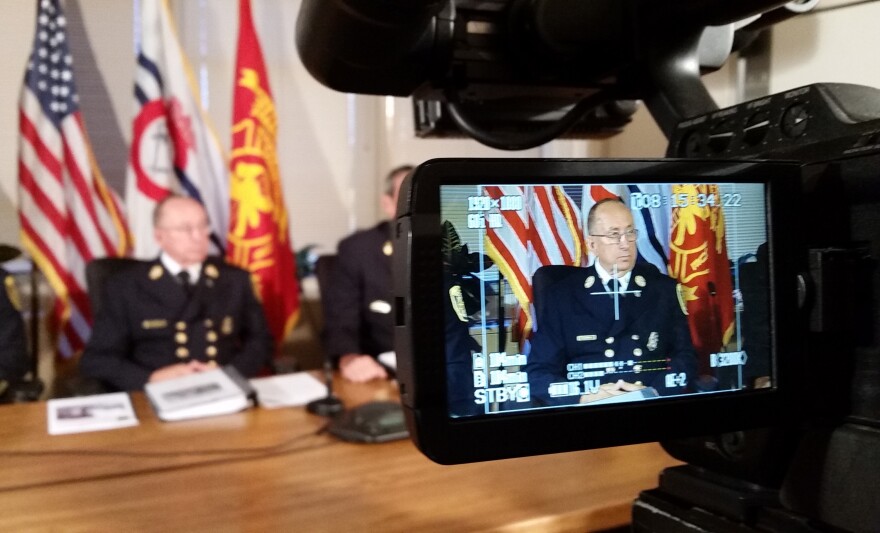A 353-page report on the investigation into the fire that led to the death of a Cincinnati firefighter confirms the death was accidental, and lays out a list of recommendations to try to ensure something like this doesn't happen again.
Fire Apparatus Operator (FAO) Daryl Gordon died March 26, 2015 while responding to a fire at 6020 Dahlgren St in Madisonville. His death was ruled accidental, caused by asphyxiation when he fell into an unlocked elevator shaft.
A big question has been why the elevator door look was not functioning since the elevator car was not present on the floor where the accident occurred.The report concludes Cincinnati police and elevator inspectors investigated the door and locking system for defects or malfunctions, but could not figure out why the door malfunctioned.
"The failure of the elevator interlock mechanism was the most significant factor in the death of FAO Gordon," the report concludes. "However, the fireground operational issues that occurred are the most concerning to the Cincinnati Fire Department."
The National Institute of Safety and Health (NIOSH) investigations included in the report agree the elevator door was the primary contributing factor. However, there were other factors at play as well.
"Operational factors included accountability procedures, understanding of modern fire behavior, fire stream tactics, fireground ventilation, and freelancing. Training factors included training division staffing, training plan, forcible entry training, and hose deployment training. Communications factors included human error, radio discipline, knowledge of radio equipment, and radio system template."
The report outlines 44 recommendations for improving training, operational logistics, radio communication skills, and equipment. It puts the price tag at approximately $2.3 million per year for all the recommendations. The funding is being spread out over the next two budget cycles.
We want to get out and do a lot more training with our guys, build that muscle memory, make us better, and to honor Daryl by doing that. I promised his wife that's what we'd do.
District Fire Chief Gregory Potter says training is a key goal moving forward. "We want to get out and do a lot more training with our guys, build that muscle memory, make us better, and to honor Daryl by doing that. I promised his wife that's what we'd do."
Fire Chief Richard Braun says many of the recommendations are already being implemented, especially related to training. "We've worked on hose lays, ladders... even with our new recruit class we have extended the times that we're doing with our hose lays and ladder operations to make us more proficient at those."
Communication proved a challenge during the Dahlgren fire. Not everyone on the scene was on the same radio channel, or talk group, which led to confusion. There were radio equipment failures that morning leading to some messages - chiefly that the elevator door was broken and opened to an empty shaft - not being relayed.
"We had 50 percent of our people on the wrong talk group (that morning)," says Braun. Talk groups are assigned based on the type of incident. For example, a working fire would be discussed on one channel, while a fire alarm would be a different channel. When an incident changes from one type of incident to another, firefighters would need to change channels. "We no longer do that. That stopped almost immediately. Once you go to a talk group, they never take you off of that talk group."
Braun says the department is changing its radios in July. The new ones will make it easier to navigate between talk groups.

Staffing is another factor the department wants to improve. One recruit class is in training and another is planned for later this year. The force is regrouping its numbers since the practice of brownouts ended in 2014. A brownout is when a piece of equipment, and the people who work on it, are taken out of service for a day because of a lack of funding or staffing.
Fire Department leaders have blamed brownouts for making on-going training nearly impossible during the time the practice was in place. However, Braun and Potter declined to say the Dahlgren incident, and Gordon's death, could have been avoided had brownouts never occurred.
What Happened
A preliminary report issued in September included this timeline:
The fire at 6020 Dahlgren Ave in Madisonville was reported at 5:31 a.m. on March 26, 2015.
- The first units on the scene arrived at 5:38 a.m.
- FAO Gordon arrived with Heavy Response unit 14 (HR-14) at 6:04 a.m.
- HR-14 members begin searching apartments on the fifth floor and mark the unlocked fifth floor elevator door "Do Not Enter Open Shaft" at 6:10 a.m.
- FAO Gordon falls down the elevator shaft at 6:12 a.m.
- Crews hear Gordon's low pressure alarm bell ringing and find his helmet in the elevator shaft at 6:22 a.m.
- Gordon is extricated by 6:36 a.m.
- CPR is initiated and he's transported to University Hospital where he's pronounced dead at 7:08 a.m.
The last recorded interaction someone had with Gordon occurred near a stairwell from the fourth floor.
The report reads:
While on the 4th/5th floor stairwell landing, L-32 FF #1 saw FAO Gordon above him at the fifth floor door.
FAO Gordon asked him “Are you HR-14?”
L-32 FF#1 responded “No, I’m with Ladder 32. Who are you?”
FAO Gordon replied “I’m Daryl Gordon."
After this verbal exchange, FAO Gordon turned around and headed back to the fifth floor hallway as L-32 FF#1 continued down the stairs with the two occupants from apt. 58



